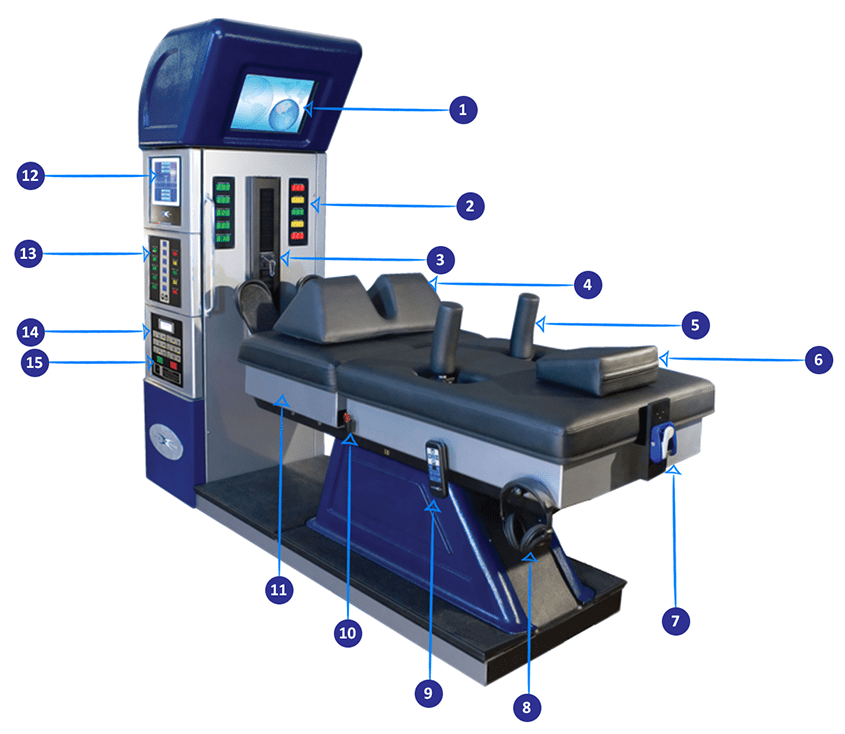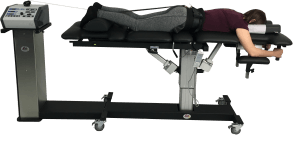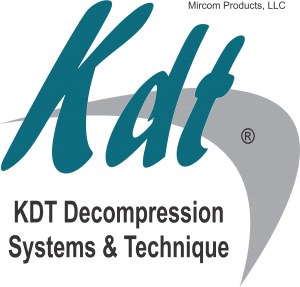Non-surgical Spinal Decompression in Chattanooga, Tennessee
As a chiropractor, non-surgical spinal decompression therapy using DRX and KDT can be a highly effective treatment option for patients undergoing physical rehabilitation. This therapy is intended to relieve back pain, particularly in the cervical and lumbar spine regions. Patients dealing with herniated discs, degenerative disc disease, sciatica, and other similar conditions may benefit from this treatment.
The only chiropractic company in Chattanooga with six spinal decompression tables.
Our professionals create non-surgical treatment programs that are tailored to your specific needs. Non-surgical decompression treats:
- Back pain
- Neck pain
- Bulging/Herniated discs
- Worn spinal joints
- Injured/diseased spinal nerve roots
- Sciatica
We offer 3 different types of spinal decompression:
DRX9000® Spinal Decompression Machine
At our office, we use only the best equipment and procedures for every spinal decompression treatment we provide.
Our professionals use high-powered technology known as the DRX-9000 to provide spinal decompression. This device allows our team to gently decompress the discs in the spine by relieving pressure on the nerves located in the lower back.
With these advancements in technology, we are able to target pain in the lower back, sciatica, and other problem areas. We are the Chattanooga's specialists in herniated discs, bulging discs, and degenerative disc disease.

Cervical Spinal Decompression
Cervical spinal decompression is a medical procedure aimed at alleviating pressure on the nerves and spinal cord in the cervical region (neck) of the spine. This pressure can be a result of various conditions, including herniated or bulging discs, spinal stenosis, bone spurs, or degenerative disc disease. When the spinal nerves or spinal cord are compressed, patients can experience symptoms such as neck pain, headaches, numbness, tingling, and weakness in the arms or hands. In some severe cases, this compression can also lead to coordination issues or difficulty walking. The goal of cervical spinal decompression is to restore the necessary space for the spinal cord and nerve roots, which can subsequently alleviate pain and improve neurological function.
There are various methods for achieving cervical spinal decompression. One common non-surgical approach is traction, where the neck is gently stretched to increase the space between the vertebrae.
KDT Spinal Decompression
KDT (Kennedy Decompression Technique) spinal decompression is a therapeutic treatment designed to alleviate pain and promote healing in the spine through the application of targeted traction. This non-surgical method employs the use of a specialized decompression table that gently stretches the spine to relieve pressure on the discs, nerves, and other structures. The primary objective is to create a negative intradiscal pressure, which can help pull herniated or bulging disc material back into place, enhancing the flow of oxygen, nutrients, and fluids essential for disc health.
KDT spinal decompression stands out because of its sophisticated computer-controlled system, which allows practitioners to tailor the treatment to each patient's specific needs. The system can adjust the force and angle of disc distraction, ensuring a more precise and effective treatment. Throughout the procedure, the patient experiences cycles of decompression and relaxation, which is believed to optimize the intake of fluids and nutrients into the discs. This method is used for treating various spinal conditions, including herniated discs, degenerative disc disease, posterior facet syndrome, and sciatica.


Non-surgical Spinal Decompression Therapy
During the procedure, the patient will lie down, while the machine gently stretches the spine. This motion relieves pressure on compressed discs, allowing them to move back into their proper position. The benefits of spinal decompression therapy include pain relief, restoration of function, and improved quality of life.
This treatment is both safe and effective, with research and clinical findings supporting its use. With proper protocols, non-surgical spinal decompression can be a successful alternative to surgery and medication. It is important to take special considerations with each patient to ensure their safety and clinical outcomes.
Both DRX and KDT have been shown to be clinically effective and are often preferred by patients. Each technique may be applied across patients with different types of spinal dysfunctions, from bulging discs to general pain. With its various benefits, non-surgical spinal decompression therapy is an excellent option to consider for patients dealing with back pain during physical rehabilitation.
How Does Non-surgical Spinal Decompression Work?
Spinal decompression therapy involves using a special traction table or motorized device to gently stretch your spine, taking pressure off the nerves and other structures that may be causing pain and discomfort. The therapy creates negative pressure between the spinal discs, which can encourage healing, reduce inflammation, and improve blood flow to the affected area. It also promotes the intake of nutrients in the spine and helps the affected area receive oxygen to stimulate healing processes.
The Safety and Effectiveness of Nonsurgical Spinal Decompression
Unlike invasive spine surgery, non-surgical spinal decompression has little to no risks and complications that surgery could present. This therapy is an FDA-approved alternative that has been proven effective in many cases. According to Healthline, spinal decompression therapy helps relieve pressure along the spine, soothe related pain and discomfort, and is recommended for patients with a wide range of spinal conditions, including herniated discs, sciatica, degenerative disc disease, and more.
Why Non-surgical Spinal Decompression is a Better Option
In addition to its safety, non-surgical spinal decompression has minimal recovery time. Unlike traditional surgeries that can take weeks or even months to recover, you can resume your daily activities in no time after receiving this therapy. It is also a lot less expensive compared to surgical procedures.
Moreover, while spinal surgery can be invasive and has the potential for complications, nonsurgical spinal decompression is gentle and non-invasive, with little to no side-effects.
Hip Decompression
The hip joint is a ball-and-socket joint responsible for bearing the body's weight and enabling a wide range of motion. Over time, excess pressure and wear on the hip can lead to pain and stiffness, often resulting from conditions such as osteoarthritis or hip impingement.
Hip decompression using a KDT table can help alleviate these symptoms by creating space within the joint, allowing for better circulation and reduced inflammation.
Knee Decompression
The knee joint is a hinge joint that connects the thigh bone (femur) to the shinbone (tibia) and is crucial for everyday activities such as walking, running, and climbing stairs. Excessive pressure on the knee joint can lead to pain, swelling, and decreased range of motion, often caused by conditions like osteoarthritis, patellofemoral pain syndrome, or meniscus tears. Knee decompression aims to reduce pressure on the joint, thereby alleviating pain and enhancing mobility.
By utilizing a KDT table, our team of medical professionals can apply gentle traction to the knee joint, creating space and reducing pressure. This targeted decompression technique can help release tension in the muscles surrounding the knee, increase joint flexibility, and improve overall knee function.
Ankle Decompression
The ankle joint plays a key role in balance and movement. Pressure on the ankle joint may result from injuries, chronic conditions like arthritis, or repetitive stress from activities such as running or jumping. Ankle decompression focuses on relieving this pressure, reducing pain, and improving joint mobility.
The KDT table allows for controlled and precise traction of the ankle joint, effectively stretching the surrounding muscles and ligaments. This targeted decompression technique can help release muscle tension, improve joint flexibility, and enhance ankle stability, ultimately reducing pain and discomfort associated with various ankle conditions.
Wrist Decompression
The wrist is a complex joint composed of multiple small bones and is crucial for various everyday activities involving hand and arm movements. Excessive pressure on the wrist joint may result from repetitive stress, injuries, or degenerative conditions such as arthritis.
Implementing wrist decompression offers a safe, controlled, and effective method to alleviate pressure within the joint. Applying gentle traction to the wrist, through the use of a KDT table helps create space between the bones and surrounding soft tissues, promoting better circulation and reduced inflammation. This targeted decompression technique can help enhance overall wrist function, ultimately reducing pain and discomfort associated with various wrist conditions.
CONTACT
ADDRESS
True Wellness Integrated Medicine
6102 Shallowford Road, Suite 103
Chattanooga, TN 37421
All Rights Reserved | True Wellness Integrated Medicine | Powered by Webive Digital Marketing | Privacy Policy




